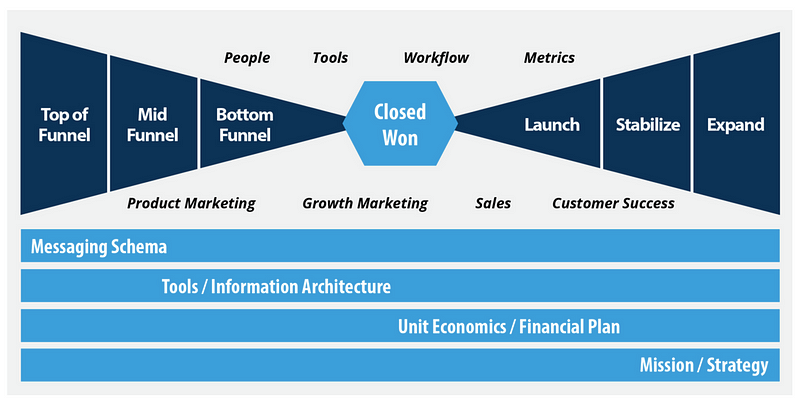In 2017, a study by Statistic Brain indicated that the failure rate of all U.S. companies after five years was over 50 percent, and over 70 percent after 10 years.¹
It is within that context that Tom Mohr decided to write a book that could tip the scales for startup CEOs. In Scaling the Revenue Engine, Mohr offers founders, CEOs, and other leaders a blueprint to build a well-oiled, revenue-generating machine.
Chapter 1 provides an overview of Mohr’s concept. He starts by challenging the prevailing framework for revenue generation that treats marketing, sales, customer success, and finance as siloed functions with separate accountabilities and arm’s length handoffs.
His alternative thesis, based on two years of in-depth research into the revenue generation practices of a diverse array of early and mid-stage tech companies, is that a revenue engine is better conceived as a whole system.
1. Rethinking your business model
As a startup, your goal is to maximize repeatable, scalable, ROI-positive revenue and profit growth. The math is quite simple: you drive ROI by maximizing your customer lifetime value (LTV) while minimizing customer acquisition cost (CAC). You seek to ensure that unit economics deliver LTV / CAC > 3. You drive growth by optimizing your pursuit of prospects and expansion spending from current customers, working within CAC boundaries.
“We tend to think of business models in terms of “media,” or “marketplace,” or “e-commerce,” or “B2C SaaS,” or “B2B SaaS (SMB / mid-market / enterprise).” But such descriptions leave opaque the key variable that differentiates them.” — Tom Mohr, Scaling the Revenue Engine.
If your goal is to create a revenue-generating strategy for your company, it’s better to describe your business model in LTV terms:
- Very Low Customer LTV (<$500)
- Low Customer LTV ($501 — $10,000)
- Mid Customer LTV ($10,001 — $100,000)
- High Customer LTV ($100,001 — $500,000)
- Very High Customer LTV ($500,001+)
Using this approach, you’ll notice that most media, marketplace, e-commerce and B2C SaaS businesses — traditionally grouped separately in terms of business model — fall into the Very Low Customer LTV bracket. This means that their approach to scaling will focus on online demand generation including SEO, SEM, digital marketing, and viral social effects.
“The point is that revenue engine strategy must start with the math of the business. Customer LTV is the grand arbiter. In order to scale, it is generally recognized that the ratio of LTV / CAC should be 3 or greater, with CAC payback less than 18 months.” — Tom Mohr, Scaling the Revenue Engine.
2. Coordination
Once you’ve reframed your business model and have a clear picture of the math that determines your ability to succeed (what numbers do we need to hit), Mohr’s core thesis is simple: rapid revenue generation is achieved through coordinated activity across the enterprise (how do we get there).
He argues for the coordination of activities at all levels, from executive to frontline. The sum of all the strategies, plans, people, tools, workflows, and metrics that create this coordinated revenue generation activity is what he calls the “revenue engine.”
Achieving this begins with a clearly defined strategy and results in finely tuned acts of daily customer engagement along the entire prospect and customer journey.
“Best practice revenue engines are built as whole systems, bounded by unit economics, with end-to-end workflows and data flows that support and orchestrate customer engagement. These metrics are tracked at every step and optimized via continuous improvement projects.” — Tom Mohr, Scaling the Revenue Engine.
3. Systems design thinking
Coordination depends on systems design thinking, implemented throughout the company, at all levels, and harnessed in the making of every strategic decision.
Mohr’s Revenue Engine framework, the Bow Tie Schema, serves as the foundation for the book.

The customer engagement journey moves from top of funnel, to mid, to bottom, to launch, stabilize and expand. Sitting below the bow tie are four foundational layers, the building blocks that support all the customer engagement activity.
“Regardless of your business model, the revenue engine’s core components are consistent. The B2C E-commerce site’s customer traverses the Bow Tie in the same sequence as does the B2B SaaS enterprise customer. No matter the business model, the imperative is to design and implement an engine that is fit, trim, constantly measured, and continuously improving.” — Tom Mohr, Scaling the Revenue Engine.
Notes
- Henry, Patrick. “Why Some Startups Succeed (And Why Most Fail)”. Entrepreneur, February 18, 2017, retrieved on May 29, 2019 from: https://www.entrepreneur.com/article/288769

